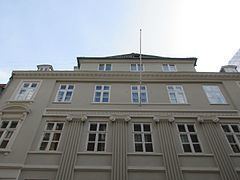Completed 1793 | Opened 1793 | |
 | ||
Similar Tivoli Gardens, Øresund Bridge, Teglværksbroen, Højbro, Dyssebroen | ||
The Waagepetersen House is a listed Neoclassical town mansion located at Store Strandstræde 18 in Copenhagen, Denmark. The house takes its name after royal wine merchant Christian Waagepetersen who owned it from 1811 to 1840. His home was a meetingplace for many of the leading figures of the Danish Golden Age.
Contents
Early history
The house was built in 1792-1793 by Johan Martin Quist. Some of the early residents in the building included the author and economist Christen Pram in 1896 and Count Cai Friedrich Reventlow in 1798-1801.
The Waagepetersen era
The wine merchant Christian Petersen (later Christian Waagepetersen) acquired the building in 1811. He lived there with his large family and also ran his business from the premises. Tenants during his ownership included the physician Frederik Ludvig Bang who lived in the building from 1812 to 1814 and the composer, conductor and violinist Claus Schall lived in the building from 1822 to 1924
Waagepetersen had a passion for the arts and his home in Store Strandstræde became a meetingplace for many of the leading figures of the Danish Golden Age in the 1820s and 1830s. He was especially fond of music as witnessed by the fact that he named three of his sons after Haydn, Mozart and Beethoven.
The musicians Weyse, Kuhlau and Hartmann were frequent guests and often performed at music soirées. Other guests included the painters Eckersberg and Wilhelm Marstrand.
Christian Waagepetersen died in 1840. The house in Store Strandstræde was then taken over by Mazart Waagepetersen and his wife Charlotte Caroline Mathilde Waagepetersen. The couple's only child was Gaston Waagepetersen, an adopted son botn outside marriage by Alce Tutein. Mazart Waagepetersen purchased the country house Tosendal in Østerbro. Both properties were sold in 1878. The family then lived at Rosenvængets Side Allé 6 in Østerbro.
Later history
The company De Forende Papirfabrikker A/S (The United Paper Mills= were based in the building from its foundation in 1889.
The Danish state acquired the building in the early 1980s. In 1984-1986, it was adapted for use as a new home for Nordic Council by the architects Ib and Jørgen Rasmussen. Nordic Council moved out in 2010 after taking over Hotel Royal's former building at Ved Stranden.
Architecture
The building consists of three storeys and a celler and is built to a somewhat unorthodox design. The three-bay median sisilit is decorated with four Ionic order pilsters on the two lower floors Above the pilasters, between the second and third floor, runs a Greek key frieze. The median risilit is not tipped by the usual triangular pediment but instead by a three bay wall dormer with a hip roof.
Today
The building was converted into 32 apartments in 2012, varying in size from 74 to 287 square metres. The two largest apartments has later been merged into one 474 square metre apartment by Joe & the Juice-founder Kasper Basse with the assistance of the architects Tom Lundberg og Stig Marvits. It was put on the market at a price of DKK 50 millions in 2016.
The building also contains three commercial tenancies. The wine bar Nabiolo has been located in the basement since May 2015.
